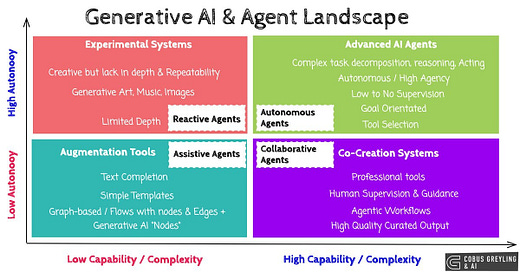Understanding the relationship between capability and autonomy has become crucial for both developers and users.
The Generative AI & Agent Landscape matrix provides a powerful framework for categorising and understanding different AI systems based on these two critical dimensions.
High Autonomy, Low Capability: Experimental Systems
In the upper-left quadrant, are systems that can operate independently but with limited depth.
Generative art, music and image creation tools that produce creative outputs but often lack repeatability, consistency and fine-grained control over details.
While these systems can work with minimal human guidance, their limited depth restricts their practical applications.
Reactive agents in this space respond to stimuli but lack sophisticated planning capabilities.
- Find me on LinkedIn or on X!
High Autonomy, High Capability: Advanced AI Agents
The upper-right quadrant represents the cutting edge of AI development — systems that combine sophisticated capabilities with high autonomy.
Advanced AI Agents excel at complex task decomposition, reasoning and independent action with minimal supervision.
AI Agents characterised by goal-oriented behaviour and can adapt to changing circumstances.
Autonomous AI Agents in this category represent the most advanced AI Agent systems available, capable of handling complex workflows with little to no human oversight.
Low Autonomy, Low Capability: Augmentation Tools
The lower-left quadrant contains tools designed to enhance human productivity rather than replace it.
These include text completion, simple templates, and graph-based systems with generative AI “nodes”.
While limited in both capability and autonomy, assistive Agents serve as effective productivity boosters in specific domains, augmenting human abilities rather than attempting to replicate them.
Low Autonomy, High Capability: Co-Creation Systems
In the lower-right quadrant, we find highly capable systems that rely on significant human guidance (co-pilots).
These professional tools enable high-quality curated outputs through collaborative human-AI partnerships (generating agentic workflows).
Requiring human supervision but delivering sophisticated results.
Collaborative agents in this space work alongside humans, in most cases the agent generates a sequence of events. The human can then accept, reject or edit steps prior to the sequence being executed.
The Evolution of AI Agents
What makes this framework particularly valuable is how it shows the evolution of AI systems. Most AI Agent development follows a trajectory from simple augmentation tools to increasingly capable and autonomous systems.
As technology advances, we’re seeing more systems move toward the upper-right quadrant, with greater independence and sophistication.
However, this doesn’t mean all AI systems should aim for maximum autonomy.
The co-creation quadrant demonstrates that some of the most powerful applications of AI come from effective human-AI collaboration rather than complete AI independence.
Implications for the Future
This framework segments not just where AI systems are today, but where they’re headed.
As capabilities increase, we can expect:
More sophisticated autonomous AI Agents capable of handling complex tasks.
Enhanced collaborative systems that leverage the complementary strengths of humans and AI
Continued specialisation across all four quadrants, with purpose-built systems for specific applications (vertical growth).
Lastly
For organisations implementing AI, understanding where different tools fall on this matrix is crucial for setting appropriate expectations and designing effective workflows.
The right approach depends not on maximising both dimensions, but on selecting the appropriate balance of capability and autonomy for each specific use case.
Chief Evangelist @ Kore.ai | I’m passionate about exploring the intersection of AI and language. From Language Models, AI Agents to Agentic Applications, Development Frameworks & Data-Centric Productivity Tools, I share insights and ideas on how these technologies are shaping the future.



